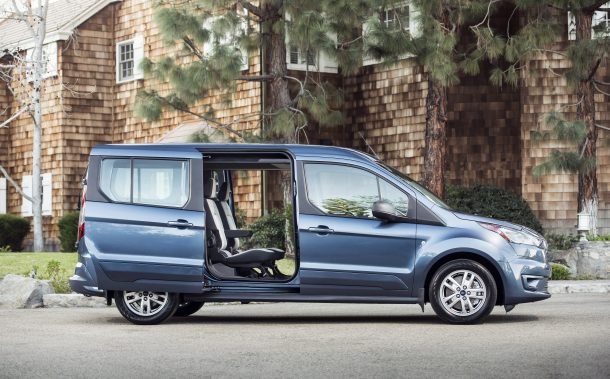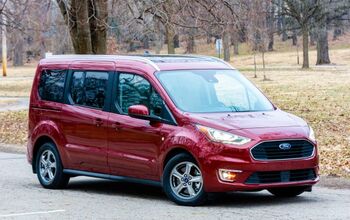2019 Ford Transit Connect: Cure for the Common Crossover?

When Ford launched the Transit Connect in North America in 2009, it was little more than a budget-friendly hauler for small business owners who needed a small van to help with their blossoming flower-delivery service. By the second generation, it received new engine options and became decidedly more passenger friendly, but remained light on features and refinement. Still, if you put a gun to the heads of a lot of car experts and asked them to pick a do-anything small vehicle, the Transit Connect would probably be on their short list.
Updated for its third generation, Ford is further enhancing the model’s versatility and comfort. However, Ford appears to be marketing the Transit Connect toward a very specific demographic — baby boomers.
While we think the Transit van’s smaller sibling probably has a far broader appeal than just the AARP crowd, things like a hip-high slide-in driver seat (with more comfortable foam), plenty of room for the grandkids, and an ultra-low load height do seem like desirable features for aging shoppers. You’d think Ford would market the Connect a viable alternative to crossovers.
However, Ford is sticking to its strategy of positioning the model for aging but active adults. It imagines a shopper of retirement age who surfs or bikes on the weekends but may still want to cart up to seven passengers (or several loads of mulch) out to dinner from time to time.
Ford’s recipe for the Transit Connect doesn’t appear to have changed all that much, at least not to the casual observer. But the automaker has equipped the updated model with two new engines, a new transmission, a mild body redesign, and fresh rear suspension. There’s also new connectivity options, upgraded seating, and plenty of new driver-assist features. Separately, none of this is enough to have a transformative effect on the small van. But Ford hopes the sum total of the changes will make it a more appetizing package for those in the market for such a vehicle.
Engine options now include a 2.0-liter direct-injected inline-four with stop/start technology and a 1.5-liter EcoBlue diesel (sourced from the European-market EcoSport and Fiesta) targeted to return an EPA-estimated fuel economy rating of at least 30 mpg highway. The 2.5-liter Duratec will also carry over, but only for base fleet applications. Engines are to be paired with an all-new eight-speed automatic transmission driving the front wheels. Basically, it’s just the nine-speed unit GM and Ford designed together with one of the gears removed.
While the manufacturer isn’t sharing specific output numbers right now, we don’t expect the Connect to become a thrilling platform for driving enthusiasts. The current generation of the van drives in a manner much smaller than it is, handling in a car-like fashion that isn’t unpleasant but could use clearly use some more pep. However, as Ford looks to be optimizing the engines for economy, we don’t expect to see a 0-60 time below 10 seconds. The turning radius will remain phenomenal, though (38.3 feet on the shorter wheelbase model).
That’s all fine. This isn’t exactly the kind of car you’d expect someone to thrash on the backroads, and improved economy really only makes it a more attractive package for budget-minded consumers. But what should really seal the deal is Ford’s promise of added tech and comfort.
The interior doesn’t look all that different from the current model, but Ford is throwing in an optional 6.5-inch screen supporting SYNC3 connectivity with the Ford/Alexa (Amazon’s Echo) personal assistant. There is also a standard 4G LTE modem capable of connecting up to 10 devices to the internet. Rear passengers can have their own temperature and fan controls, along with both 12-volt and 110-volt outlets.
Ford claims to have introduced structural updates on the Connect that should improve crash performance. But the real safety net is the new driver-assist features. A camera-based system with forward collision warning and pedestrian detection and automatic emergency braking is now standard on all trim levels. Lane keeping (with assist and vibrating departure alert), blind spot monitoring, rear cross-traffic alert, and adaptive cruise control are optional, however. These should come in handy for Ford’s aging demographic target once their senses begin to betray them.
For someone with even the most remote interest in small vans or utility vehicles, the overall package looks more than serviceable. Dual-sliding doors are good, flat-folding seats are good, better fuel economy is good, big windows are good, tons of room without handling like a shopping cart is good. But we’re hoping Ford managed to add in an element of refinement that the second generation model improved upon, but ultimately still lacked.
The 2019 Transit Connect wagon should begin appearing at dealerships this fall, available in XL, XLT, and Titanium trim levels with variable lengths. Ford hasn’t talked price, but we’d expect something in the neighborhood of the 2018 model. That leaves you with a base unit starting below $26,000 and a tricked out Titanium for around $32,000.
[Images: Ford Motor Company]

A staunch consumer advocate tracking industry trends and regulation. Before joining TTAC, Matt spent a decade working for marketing and research firms based in NYC. Clients included several of the world’s largest automakers, global tire brands, and aftermarket part suppliers. Dissatisfied with the corporate world and resentful of having to wear suits everyday, he pivoted to writing about cars. Since then, that man has become an ardent supporter of the right-to-repair movement, been interviewed on the auto industry by national radio broadcasts, driven more rental cars than anyone ever should, participated in amateur rallying events, and received the requisite minimum training as sanctioned by the SCCA. Handy with a wrench, Matt grew up surrounded by Detroit auto workers and managed to get a pizza delivery job before he was legally eligible. He later found himself driving box trucks through Manhattan, guaranteeing future sympathy for actual truckers. He continues to conduct research pertaining to the automotive sector as an independent contractor and has since moved back to his native Michigan, closer to where the cars are born. A contrarian, Matt claims to prefer understeer — stating that front and all-wheel drive vehicles cater best to his driving style.
More by Matt Posky
Latest Car Reviews
Read moreLatest Product Reviews
Read moreRecent Comments
- Redapple2 4 Keys to a Safe, Modern, Prosperous Society1 Cheap Energy2 Meritocracy. The best person gets the job. Regardless.3 Free Speech. Fair and strong press.4 Law and Order. Do a crime. Get punished.One large group is damaging the above 4. The other party holds them as key. You are Iran or Zimbabwe without them.
- Alan Where's Earnest? TX? NM? AR? Must be a new Tesla plant the Earnest plant.
- Alan Change will occur and a sloppy transition to a more environmentally friendly society will occur. There will be plenty of screaming and kicking in the process.I don't know why certain individuals keep on touting that what is put forward will occur. It's all talk and BS, but the transition will occur eventually.This conversation is no different to union demands, does the union always get what they want, or a portion of their demands? Green ideas will be put forward to discuss and debate and an outcome will be had.Hydrogen is the only logical form of renewable energy to power transport in the future. Why? Like oil the materials to manufacture batteries is limited.
- Alan As the established auto manufacturers become better at producing EVs I think Tesla will lay off more workers.In 2019 Tesla held 81% of the US EV market. 2023 it has dwindled to 54% of the US market. If this trend continues Tesla will definitely downsize more.There is one thing that the established auto manufacturers do better than Tesla. That is generate new models. Tesla seems unable to refresh its lineup quick enough against competition. Sort of like why did Sears go broke? Sears was the mail order king, one would think it would of been easier to transition to online sales. Sears couldn't adapt to on line shopping competitively, so Amazon killed it.
- Alan I wonder if China has Great Wall condos?








































Comments
Join the conversation
This car needs the C-Max Hybrid and Energi powertrains (and the C-Max's level of refinement). That would make it the ultimate Uber-mobile for commercial drivers, and the ultimate green adventure wagon for people who want to camp in it or lock their bikes safely inside.
I drive a TC at work and although it's nice to drive compared to the full size vans I also drive, it's pretty crude compared to my parent's Mazda5. Even empty it takes time to get up to highway speed and the motor makes more noise and vibration doing it than I've come to expect in anything other than a truck. When I first saw them I immediately thought 'minimalist DIY camper' but now my ideas in that direction start with an old Toyota Previa with 4WD and a stick. I also see a lot of RHD micro vans with Daihatsu nameplates around these days, many apparently having 4WD and turbo powerplants. Haven't driven one yet though...